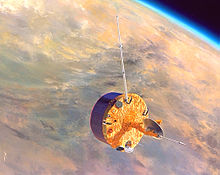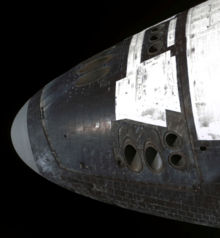Stabilization (space travel)
In space travel , stabilization means that an axis of a spacecraft maintains a certain direction in space without any further action . Two mechanisms of action can be used for this, the gravitational gradient or the rotation (spin).
In contrast, position control means changing the spatial orientation of three axes at will , see Attitude Determination and Control System .
Gravitational stabilization

Gravitational stabilization is only possible in the vicinity of a heavy celestial body . While the spacecraft follows the mean gravitational acceleration in its free fall , its parts facing the celestial body are subject to a higher attraction, the parts facing away from a higher centrifugal acceleration .
This gravity gradient can be used for stabilization by making the missile elongated, i.e. with a dominant axis of the inertia tensor . As long as the main axes are oriented obliquely with respect to the radius vector from the celestial body to the missile, a torque acts through the gradient with the tendency to align the longitudinal axis of the missile parallel to the radius vector. The satellite is designed in such a way that it can perform its task in this stable position. Older earth observation satellites and the space shuttle used this method when it did not need to occupy a particular position in space.
There is no stabilization with respect to a rotation about the longitudinal axis .
Spin stabilization

Spin stabilization makes use of the effect that a spacecraft rotating around its longitudinal axis (No. 1 in the overview image) behaves like a top and therefore normally cannot be moved out of its position in space; this also applies if the spacecraft is in the gravitational field of a celestial body . The self-rotation gives the spacecraft sufficient stability around the two axes that are perpendicular to the axis of rotation.
A disadvantage is that the spin axis can only be aligned as desired in space with additional steering thrusters. In addition, only half of the solar cells attached to the outer shell are illuminated by the sun.
The best known example of a spin stabilized satellite is the earth with its daily rotation . Another example are spin-stabilized communications satellites, which align their spin axis in such a way that the solar cells on their drum surface are illuminated by the sun one after the other as they rotate around their axis, while at the same time their antennas, sitting at one end of the drum, are untwisted by a motor. so that they can always point to the same target area on earth. One also speaks of a dual-spin system .
Since the orientation is absolutely stabilized in weightlessness and not relative to the earth, a spin axis at right angles to the orbit surface is normally used. Otherwise a spin axis, which initially points to the center of the earth - in the case of a circular orbit - would run tangential to this after a quarter of the orbit , and after halfway the other side of the spin axis would point to the earth.
See also: Yo-yo de-spin to reduce your own rotation
Twist stabilization
With spin stabilization, it is not the entire spacecraft that rotates around its axis, but an inertia wheel inside the spacecraft ((2) in the figure). The wheel of inertia is a massively rotating body, whose axis is immobile in relation to the spacecraft. The gyroscopic force thus generated stabilizes the spacecraft. A single spin wheel is sufficient for stabilization, but some spacecraft have several due to the failure safety .
The advantage of the spin stabilization is that the spacecraft can be firmly aligned in order to align antennas to the earth, solar panels to the sun or observation instruments to the target object. Stabilization around the axis of rotation takes place by changing the speed and the associated reaction torque. With this type of stabilization, too, the spacecraft and thus also the axis of the spin wheel can be rotated arbitrarily in space by control engines. The control nozzles are also used to correct the drift from time to time in the case of constantly acting disturbance torques. In English this is known as the biased momentum system or momentum-bias system .
Some earth observation satellites are stabilized in this way. The European communications satellite Symphonie also contained such a system. The space shuttle, on the other hand, usually only uses steering jets. However, during the STS-99 mission in 2000, a leak occurred in a line. In order not to have to abort the mission prematurely, energy was saved in various ways, and training on the ergometer also improved the stabilization of the space shuttle.
Position control by reaction wheels

The position control by reaction wheels (no. 3 in the figure) is not related to the spin stabilization, since its gyroscopic effect is undesirable in this case . Instead, sensors use reaction wheels to determine the position in space in relation to the sun and the celestial body orbiting it. The data determined in this way are converted into control commands to the reaction flywheels.
In the case of rigidly mounted reaction wheels, the required wheels are accelerated or braked. Due to the rules of the conservation of angular momentum in the overall satellite system, the satellite housing moves in the opposite direction.
Since no impulse acts in the initial state (non-rotating reaction wheels), such a system is also called a zero-bias system or zero-momentum bias system .
Since the speed of rotation and thus the maximum angular momentum that can be generated is limited, the system must be “desaturated” from time to time after several corrections in the same direction. For this purpose, the satellite is "held" with control nozzles or (in the vicinity of planets with strong magnetic fields) magnetic coils in order to reduce the total angular momentum of the wheels back to zero.
Typically, at least three orthogonally arranged reaction wheels are used, one for each spatial axis. Often a fourth wheel is arranged at an angle to protect against failure , or all four wheels are arranged like the surfaces of a tetrahedron . The Hubble space telescope has four large reaction wheels in a different arrangement for position control. Various optical and magnetic systems as well as small gyroscopes are used as sensors , of which six are available for redundancy reasons , but normally only three are active. Control nozzles can not be used for position control in the Hubble telescope because of the contamination they cause . Magnetic control is used here (see next section).
While three components of the angular momentum vector are changed with reaction wheels , the direction and size of this vector are set with the Control Moment Gyro ( moment gyro ) (No. 4 in the figure). A constantly rotating inertia wheel in a cardanic suspension is used for this . This is not free, but is adjusted by a motor in two orthogonal directions. The resulting reaction torque turns the spacecraft. The rotation around the axis of the inertia wheel is controlled by speed changes. This technology is used, for example, on the International Space Station .
Compared to reaction wheels and torque gyroscopes, the effect of control nozzles is gross. Their exclusive use is also wasteful, because a rotation initiated by it must soon be brought to a standstill again with an opposite impulse.
Ultimately, the service life of the entire system is mainly determined by
- the service life of the reaction wheels, since rapidly rotating parts are always particularly prone to failure, and
- the fuel supply for the desaturation described above.
In the case of communication satellites with a fixed orientation to the earth, the main axes have the usual aircraft designations, see roll-pitch-yaw . One example are 3-axis stabilized communication satellites, which in this way constantly align their antennas to the earth, while the solar paddles protruding from the satellite body can follow the sun.
Other procedures
- Satellites flying in the lower earth orbit (LEO) can use the earth's magnetic field to control their position. This can be done passively by means of a bar magnet so that the satellites can align themselves with the earth's magnetic field like compass needles .
The active control with magnetic coils ( magnetic torquers), which are also used to untwist reaction wheels when they have reached their highest speed, is more demanding. This method is used in the Hubble Space Telescope . - Solar flaps are a seldom used variant for position control . These movable surfaces can generate a torque by using the solar pressure or the low earth atmosphere that exists in the lower LEO (<300 km) and thus change the position of the satellite.
Web links
- Basic Concepts of Manned Spacecraft Design : 4.3.1 Space Vehicle Control Systems (PDF; 5.7 MB), Federal Aviation Administration, September 2005


